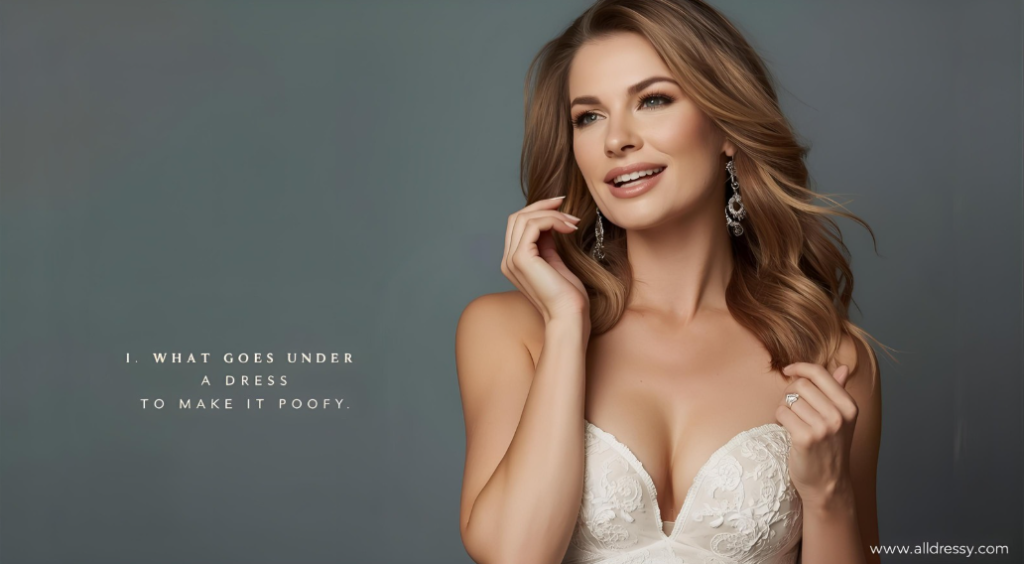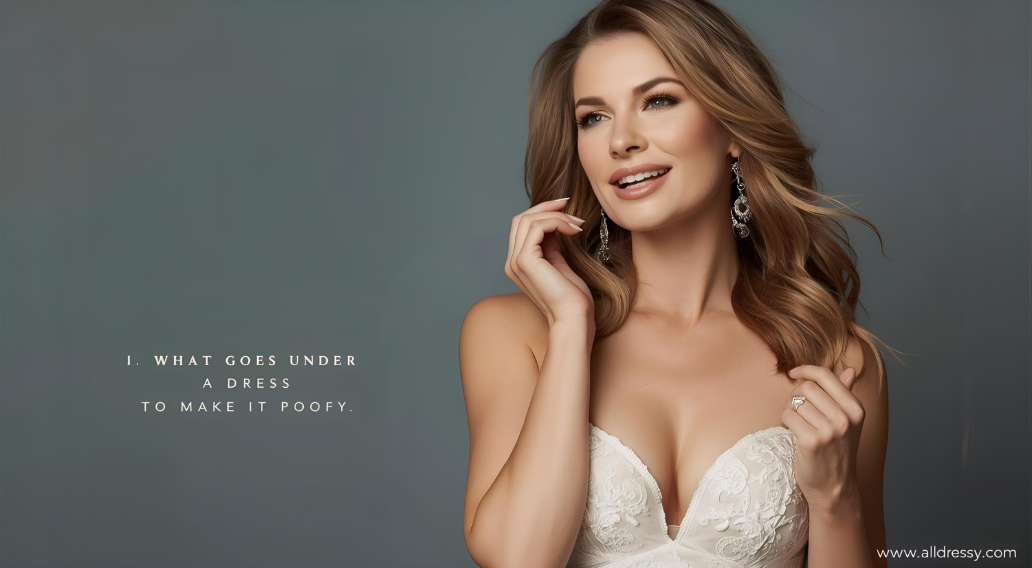There is a certain magic to a dress with a beautiful, full, voluminous skirt. From the fairytale ball gowns of Disney princesses to the classic elegance of a 1950s prom dress, a poofy silhouette creates a dramatic, feminine, and unforgettable statement. But achieving that perfect, cloud-like volume isn’t just about the dress itself; it’s about the hidden architecture beneath. If you’ve ever wondered what goes under a dress to make it poofy, you’ve come to the right place. This foundational layer is the secret to transforming a flat piece of fabric into a stunning, shape-filled masterpiece.
This comprehensive guide is your definitive resource for understanding and choosing the right underpinnings to create your desired volume. We will explore the entire spectrum of options, from simple slips to elaborate layered structures. Knowing what goes under a dress to make it poofy empowers you to customize your look for any occasion, whether it’s a wedding, a formal gala, a cosplay event, or just a day when you want to feel especially glamorous. We will cover the history, the different types of foundation garments, how to choose based on your dress style, and how to ensure you remain comfortable while looking spectacular.
The Foundation of Fashion: A Brief History of the Poof
The desire for a voluminous skirt is not a modern trend. For centuries, women have used various structures to achieve a fashionable silhouette.

- The 16th to 18th Centuries: The farthingale and later the pannier created wide, often oval or square silhouettes at the hips, a symbol of wealth and status.
- The 19th Century: The crinoline, a cage-like structure made of hoops, replaced layers of heavy petticoats, creating the enormous bell-shaped skirts of the Victorian era.
- The 1950s: Following the austerity of World War II, Christian Dior’s “New Look” celebrated ultra-feminine silhouettes with cinched waists and full, poofy skirts. This was achieved with layers of stiffened petticoats, often made from nylon tulle.
- Today: Modern underpinnings are more comfortable and versatile than ever, but they still draw inspiration from these historical foundations, using advanced materials like plastic hoops and synthetic tulle to create dramatic shapes.
The Modern Arsenal: What Goes Under a Dress to Make It Poofy
Today, you have a range of options to achieve volume, from subtle lift to dramatic, room-filling grandeur. Here is a breakdown of the key players.
1. The Slip: The Subtle Foundation
While a standard slip is designed for smoothness and opacity, a full slip made from a stiffer fabric like taffeta can add a small amount of gentle volume and help a skirt hold its shape. It’s the most lightweight and discreet option for a slight boost.
2. The Petticoat: The Classic Volume-Booster
This is the most common and versatile answer to the question of what goes under a dress to make it poofy. A petticoat is a separate underskirt designed to add fullness. They come in several forms:
- Tulle Petticoat: Made from layers of stiff netting (tulle), this is the classic choice. The volume is determined by the number of layers and the stiffness of the tulle.
- Soft Tulle: Creates a softer, more ethereal and flowing volume.
- Stiff Tulle/Horsehair Tulle: Provides significant structure and a more pronounced “poof.” Horsehair braid (a stiff nylon band) is often sewn into the hem to help the skirt hold its shape.
- Pouf Slip: A hybrid between a slip and a petticoat. It typically has a smooth, satin or cotton outer layer (so it doesn’t snag on the dress) with one or two layers of tulle attached underneath. This is ideal for achieving moderate volume with a smooth silhouette.
3. The Crinoline: The Structured Cage
The term “crinoline” is often used interchangeably with “petticoat,” but technically, a crinoline refers to a hooped underskirt. This is a framework of concentric horizontal hoops, usually made of flexible plastic or metal, connected by vertical tapes.
- Why it Works: Crinolines create maximum volume with minimal weight and bulk. Instead of relying on layers of fabric, they use the structural integrity of the hoops to hold the skirt out.
- The A-Line Crinoline: Creates a classic, triangular silhouette that flares out gently from the waist.
- The Bell-Shaped Crinoline: Creates a more rounded, “cupcake” shape, perfect for a classic ball gown.
- The Victorian/Historical Crinoline: Designed to create the extremely wide, historical silhouette.
4. Layered Combinations: Maximum Drama
For the ultimate volume, such as that needed for a wedding gown, competition ballroom dress, or high-level cosplay, layers are combined. A common combination is:
- A hooped crinoline to create the primary structure and width.
- A tulle petticoat layered over the crinoline to soften the lines, hide the hoop ridges, and add extra fullness.
Choosing the Right Foundation for Your Dress
Selecting the right underpinning is crucial. The wrong choice can create an awkward silhouette or damage the dress.
What Goes Under an A-Line Dress to Make It Poofy?
The goal with an A-line dress is to enhance its natural triangular shape without creating a rounded bell.
- Best Choice: An A-line crinoline or an A-line petticoat. These are designed to be fuller at the hem than at the hips, perfectly complementing the dress’s cut.
- What to Avoid: A bell-shaped crinoline, which would distort the A-line silhouette into a more rounded form.
What Goes Under a Ball Gown to Make It Poofy?
A ball gown is defined by its fitted bodice and very full, often rounded, skirt.
- Best Choice: A bell-shaped crinoline is ideal for creating that classic, storybook princess shape. For even more volume, a multi-layered bell petticoat with stiff tulle or horsehair trim is perfect.
- Tip: The weight of a heavy ball gown often requires the support of a crinoline to prevent the skirt from collapsing under its own weight.
What Goes Under a Fit-and-Flare Dress to Make It Poofy?
This style is fitted through the bodice and hips, then flares out at the mid-thigh or knee.
- Best Choice: A knee-length or tea-length petticoat. The goal is to add volume to the flared portion without adding bulk to the hips. A shorter petticoat or a pouf slip is ideal.
- What to Avoid: A full-length crinoline or petticoat that extends into the fitted hip area, which will create awkward bulges.
What Goes Under a Wedding Dress to Make It Poofy?
This depends entirely on the silhouette of the wedding dress (A-line, Ball Gown, etc.). Most bridal salons will recommend or provide the appropriate foundation garment as part of the dress purchase. It is often a custom-combination of a crinoline and a petticoat tailored to the specific dress.
Key Considerations: Length, Volume, and Comfort
When shopping for an underskirt, keep these three factors in mind:
- Length: The petticoat or crinoline should be 1-2 inches shorter than your dress. This prevents it from peeking out at the hem while still fully supporting the skirt.
- Volume: Consider the occasion. A subtle 2-layer petticoat might be perfect for a party, while a 6-layer petticoat or large crinoline is better for a black-tie gala or cosplay. Start with less volume; you can often add more, but it’s hard to subtract.
- Comfort: This is paramount. A petticoat should not be so tight at the waist that it causes discomfort. Crinolines are generally more comfortable for long wear as they are lightweight and don’t trap heat like multiple tulle layers can. However, be mindful of sitting in a large crinoline—practice sitting down gracefully to manage the hoops!
Practical Tips for Wearing and Caring for Your Undergarments
- Putting It On: Always put on your volume-creating underskirt before your dress. Gather the petticoat or crinoline and step into it, then pull it up. Have a helper hold your dress ready for you to step into.
- Sitting Down: For petticoats, simply sit. The tulle will compress. For crinolines, you may need to gently press down on the back of the hoops as you sit to collapse them slightly and prevent them from tipping forward.
- Walking: Be aware of your surroundings. A wide skirt requires more space to move through doorways and between tables. Practice walking to get a feel for the full dimensions of your skirt.
- Storage: To maintain the shape of a petticoat, hang it by the waistband. Do not fold it, as this can permanently crease the tulle. A crinoline can be folded gently or hung.
Frequently Asked Questions
What is the difference between a crinoline and a petticoat?
This is the most common point of confusion.
- A Petticoat is an underskirt made of fabric layers (like tulle) to add fullness.
- A Crinoline is a structured underskirt made of hoops (plastic/metal) to create a shape.
In modern usage, “crinoline” is often used to describe a stiff, multi-layered petticoat, but for precise shopping, knowing the distinction is key.
Can I make my own petticoat?
Yes, it is possible for those with sewing experience. It involves gathering long strips of tulle and sewing them onto a waistband. However, it can be a time-consuming and messy project (tulle sheds and is tricky to work with). For most people, purchasing a ready-made petticoat is more cost-effective and reliable.
How do I know how much poof I need?
The best way is to try your dress on with different underskirts. If that’s not possible, consider the dress’s design. A dress with a lot of fabric and built-in structure will need less help than a thin, soft dress. Look at the dress’s skirt: if it’s made of multiple layers of a heavy fabric like satin or organza, it may only need a crinoline for shape. A single-layer chiffon dress will need a full petticoat to achieve any significant volume.
Will a petticoat be itchy or uncomfortable?
Quality matters. Cheap petticoats may use rough tulle and have exposed seams that can irritate the skin. Look for petticoats with a soft, satin or cotton waistband and a smooth inner layer (a “pouf slip” is great for this). The layers of tulle should not directly touch your skin.
What goes under a dress to make it poofy without a petticoat?
For a quick, DIY solution, you can layer other skirts. A tutu or a full, tulle skirt worn underneath can add volume. In a real pinch, leggings or pants won’t work, but a stiff, A-line skirt from your closet might provide a subtle boost. However, for guaranteed, controlled volume, a dedicated petticoat or crinoline is always the best solution.
Conclusion: Build Your Dream Silhouette
Understanding what goes under a dress to make it poofy unlocks a new dimension of personal style. It’s the secret knowledge that allows you to transform a beautiful dress into a breathtaking one. From the subtle lift of a pouf slip to the dramatic architecture of a hoop crinoline, these foundational garments are the unsung heroes of red carpets, weddings, and any event where making an entrance is the goal.
This guide has equipped you with the knowledge to choose the perfect foundation based on your dress’s style, your desired level of volume, and your need for comfort. Remember that the right underpinning should not only create a beautiful shape but also make you feel confident and empowered. So, the next time you slip into a dress that calls for a little extra magic, you’ll know exactly what to wear underneath to achieve that perfect, show-stopping poof. Embrace the volume, and step into the silhouette of your dreams.

